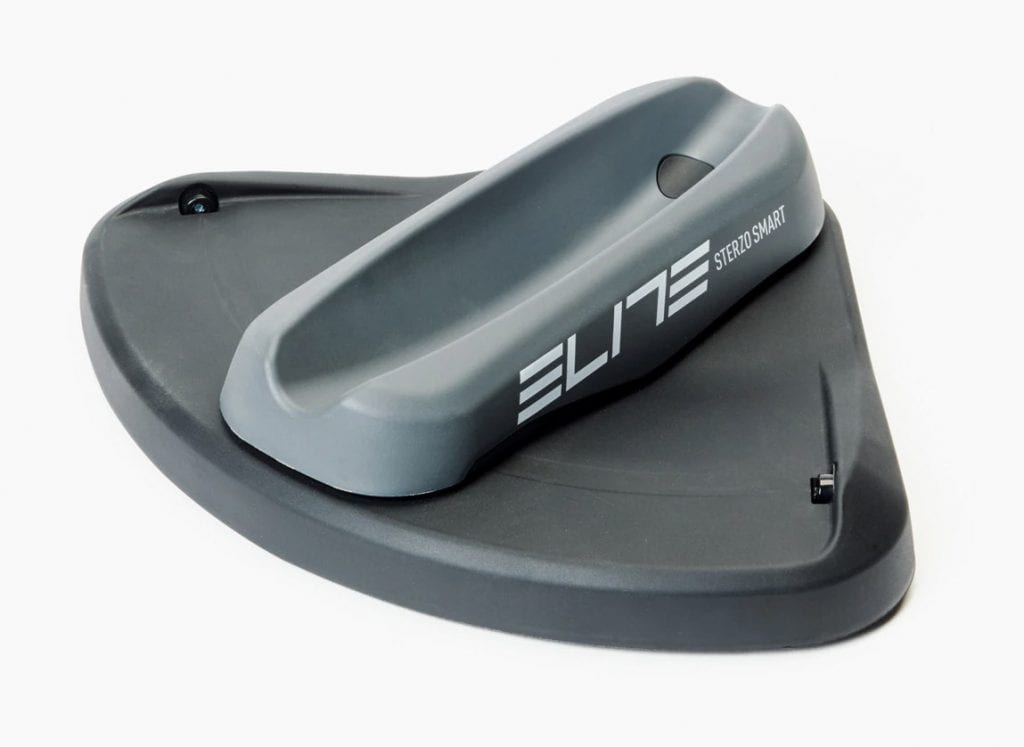UPDATE (Sept 9, 2020): Good news! Elite made several improvements to the Sterzo Smart’s design in order to prevent rust/corrosion issues and simplify setup. Read about it >
Thanks to the new FutureWorks Steering feature, Zwifters can steer on all roads in game. It’s fun, especially in races!
Now that I’ve put 20+ hours into my Elite Sterzo Smart, I figured it was time to review this unit. Additionally, sweat corrosion issues have started rearing their ugly head for some Zwifters, so I wanted to share that info and some tips for avoiding sweat-induced problems. Let’s get to it!
A Note About Supply
Zwifters must purchase an Elite Sterzo Smart steering block in order to steer on all roads. But Zwift quickly sold out of its stock and doesn’t expect more until early September. Someone seriously underestimated demand for these units!
I reached out to Elite and Zwift to inquire about when stock will be available for purchase, but that’s not an easy answer to give since Elite ships to distributors who then ship to specific stores. So while I don’t have super-specific dates, I do have this from Elite:
We are shipping product as we speak and we have taken actions to increase our production capacities by adding a new production line. We will start to see the benefits as early as next week. And some air-freight shipments are being done to reduce transit time from here in Italy where the Sterzo Smart is made to overseas customers.
The Elite Sterzo Smart will be available at other online retailers, but I don’t have that list yet.
Setup
Setup is quite simple. Unbox it, install the batteries, and place it under your front tire in the right direction. Easy!
My one complaint: the battery compartment (3 AAA batteries) has a small screw holding it closed. I’m not a fan of batteries that require tools to install – we live in the age of plastics, CAD software, and 3D printing. Certainly we can figure out a battery compartment that can be opened by hand!
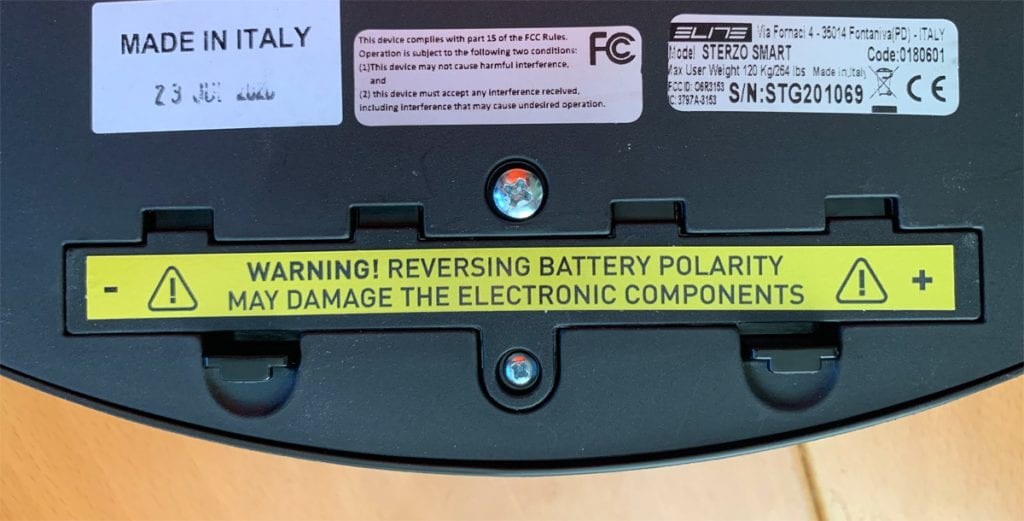
When the battery compartment is poorly-designed in the first place, it’s like Elite is making me do extra work without any actual benefit. (If it uses an actual screw, shouldn’t it be tightly sealed?) But more on that seal issue later…
Pairing Up
Moving your front wheel back and forth a bit will wake up the Sterzo, then it’s just a matter of starting up Zwift and pairing the Sterzo on the pairing screen. Typically this is a quick process, but I found that sometimes the “searching” window would take 20-30 seconds to find the Sterzo, even though the Sterzo was awake and blinking.
Pairing got more dicey mid-ride, if I decided to unpair the Sterzo and repair it. Zwift seems to have a really hard time finding the Sterzo in this situation, although it seems to find it eventually. I’m not sure if this is a Zwift issue (not searching for the Sterzo properly) or an Elite issue (perhaps the Sterzo still thinks it’s paired, so it isn’t broadcasting via Bluetooth in order to pair properly?) Regardless, this step needs some help.
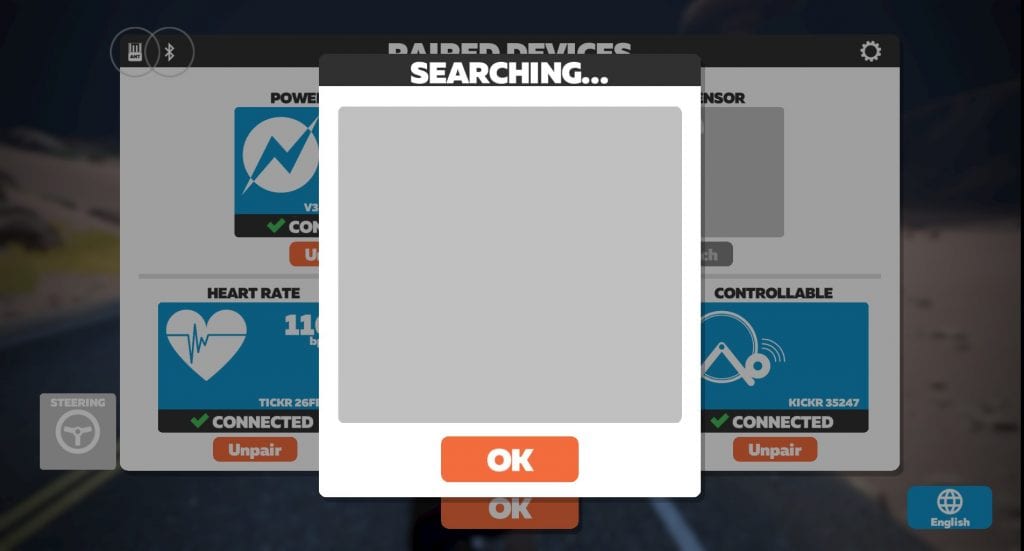
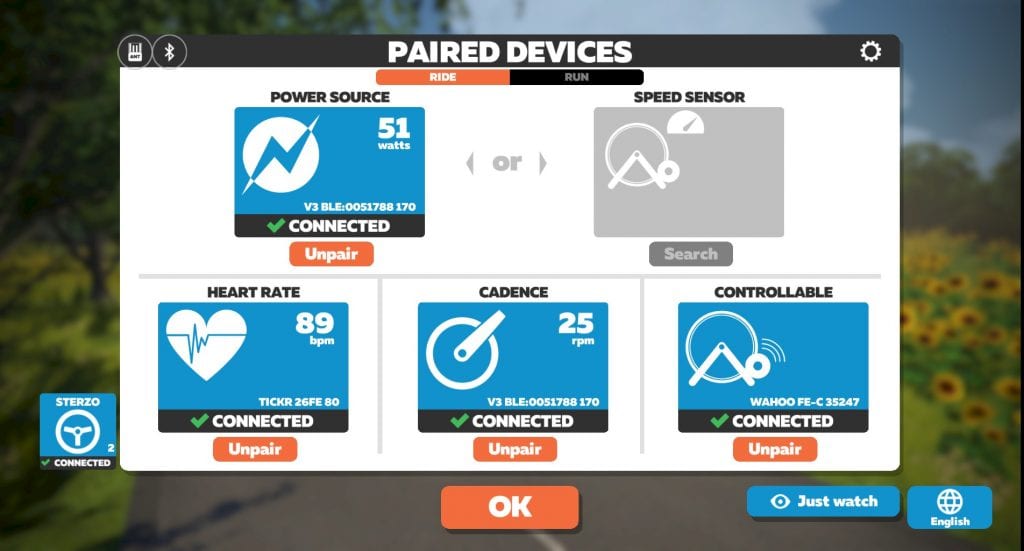
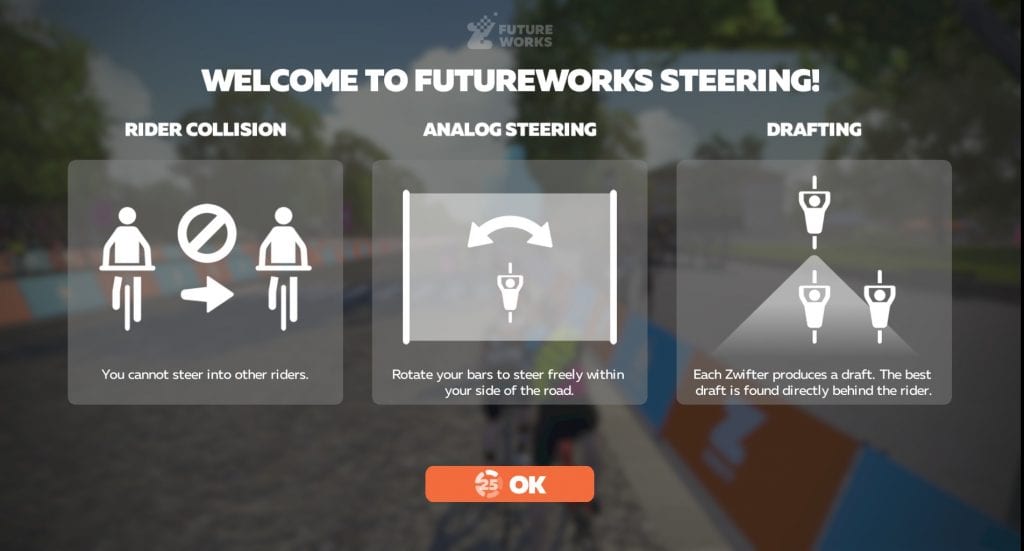
Once you are paired, you can move your wheel back and forth to see the reading for the Sterzo on the pairing screen. And once you begin your ride, you will be greeted with a Welcome screen that explains how FutureWorks steering functions. A simple, straightforward explanation… although I’d like the screen to stop showing up now that I’ve used my Sterzo for several hours.
In-Game Experience
Before I talk about what it’s like to ride in Zwift with the Sterzo, you must understand a few things about FutureWorks Steering:
- If you don’t steer at all, you will basically stay in the same left to right lane position during the ride. Think of the road like a slot car track, with (I think) 12 slots in it. As you steer, you are moving between those slots. If you don’t steer, you stay in your slot… although you may get bumped around a bit when moving through other riders.
- You can ride through riders front to back. When that happens, Zwift automatically steers your rider around the other rider.
- You cannot ride through other riders side to side. So if you want to cut a corner sharp, but there’s a group of riders on your inside, you won’t be able to move all the way over.
Physical Steering “Feel”
Steering with the Sterzo on Zwift doesn’t feel exactly like steering outdoors. Outside, at any significant speed, bike steering is done more by leaning (and even countersteering) than it is pointing your front wheel in the direction you want to travel. Zwift steering feels more like what you experience when climbing slowly on a mountain bike, when you actually do point your wheel in the direction you need to go, and leaning isn’t an option.
One thing I really liked about the steering on the Companion app was that I could lean into turns and the app saw that as steering. That doesn’t happen with the Sterzo, obviously, because the Sterzo doesn’t know you’re leaning. That said, I still find myself leaning (on my rocker plate) into turns with the Sterzo!
The Sterzo is spring-loaded, so it stays centered unless you actively turn your handlebars. It’s a pretty stiff spring, too, which is good because we want to minimize accidental turning when riding out of the saddle or sprinting.
The Head Tube Angle Challenge
When Zwift first released steering via Companion on Repack Ridge, there was a lot of talk about creating a steering turntable which doesn’t force your trainer to “walk” as you turn the bars. It wasn’t easy, because the turntable needed to be tilted up to match your head tube angle.
I was curious how Elite would handle this challenge with the Sterzo, since the angle really depends on your specific bike. The Sterzo is certainly designed with some head tube angle in mind, but I found that it still pulled on my rear triangle quite a bit when steering – especially if I turned the handlebars to more extreme angles. I also found that it was harder than I’d like to turn my handlebars, due to the angle not being correct.
I ended up putting a small block approximately 1″ tall beneath the front of the Sterzo, tilting it up for a better fit with my Roubaix SL4’s head tube angle. This made it easier to turn, and noticeably reduced the movement in my rear triangle.
Race Positioning
Being unable to steer through riders left to right makes positioning a challenge in races with a lot of sharp corners such as Crit City. If you want the fastest line, you have to find a gap in the riders in order to cut the corner. This means anticipating the turn and moving over when there is an opening. It also means that, the busier the race is, the less your chance of an efficient line!
This isn’t a bad thing – in fact, it’s very realistic. In an outdoor crit race, everyone knows you can corner more efficiently when you’re on the front, or in a small group than when you’re in a mass of 50 riders. I think we’ll find that racing with the Sterzo is more fun in smaller groups, and more fun if more of your competitors are also using the Sterzo.
Clearly, the Sterzo will be a huge advantage in TT races, since pack positioning will be a minor issue and optimized lines will trim valuable seconds off riders’ times.
The sharper the turn, the more you can gain from cutting the corner. So you may find that you only focus on a couple of key corners, such as the hairpin leading into the finishing straight on Crit City’s Downtown Dolphin route. Making your corners count is important, too, because you may pop out of the draft while you’re doing it! Let’s talk about the draft…
Watch my recent Crit City race to see how this plays out in an actual event:
Dodging the Draft
If the pack is on one side of the road, and you’re cutting the corner on the other side of the road, your rider will often go from the sitting up “drafting” position to the crouched “out of the draft” position, indicating you aren’t receiving any draft benefit. That’s a bad thing in races, where conserving your energy is paramount.
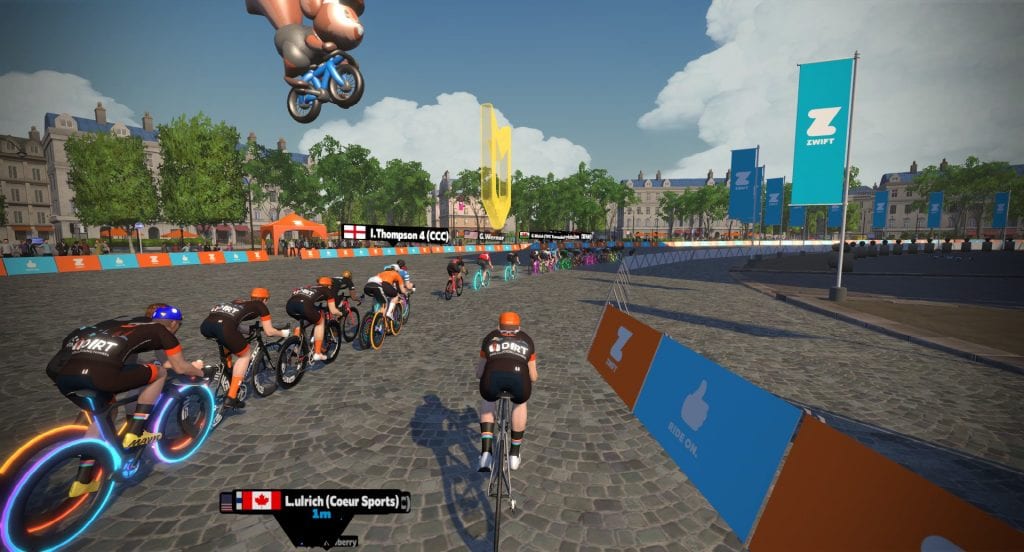
If you’re going to pop out of the draft, make it count, then get back into that draft as quickly as possible.
It’s worth nothing that the Tron bike does not show your avatar changing position based on draft status. This puts Tron riders at a bit of a disadvantage when steering in races.
Is It Faster?
Steering makes the ride more engaging and immersive, no one will argue that. But is it actually faster in a race? Absolutely yes, if you do it right.
Here’s the test I did: two laps of the Downtown Dolphin route at 250 watts steady, with no other riders on course. One lap without steering, one lap with steering.
- No steering: 3 minutes, 11 seconds
- Steering: 3 minutes, 4 seconds
So steering saved me 7 seconds on just one lap of the 1.2-mile route. That’s significant! Bearing in mind that you probably won’t be able to hit every corner perfectly when riding with others, and that lap times are shorter in races, I would say steering still gives you a 2-4 second per lap advantage on Crit City. That’s much more than any bike frame or wheelset gives you.
Battery + Rust Concerns
I’ve already seen a handful of posts from Zwifters dealing with rust issues on their new Sterzos. Hopefully this post will help other Sterzo owners avoid these problems!
There are two areas of rust concern on the Sterzo:
- Battery Compartment: if you’re sweating on a softer foam floor (common in pain caves), that sweat can go beneath your Sterzo and work its way into the battery compartment. This will quickly corrode the batteries and contacts.
- Rollers: sweat falling on the main platform of the Sterzo gets picked up by the rollers beneath the wheel holder, and those rollers quickly rust.
Here’s what those rust issues look like (after just three days of Sterzo use):
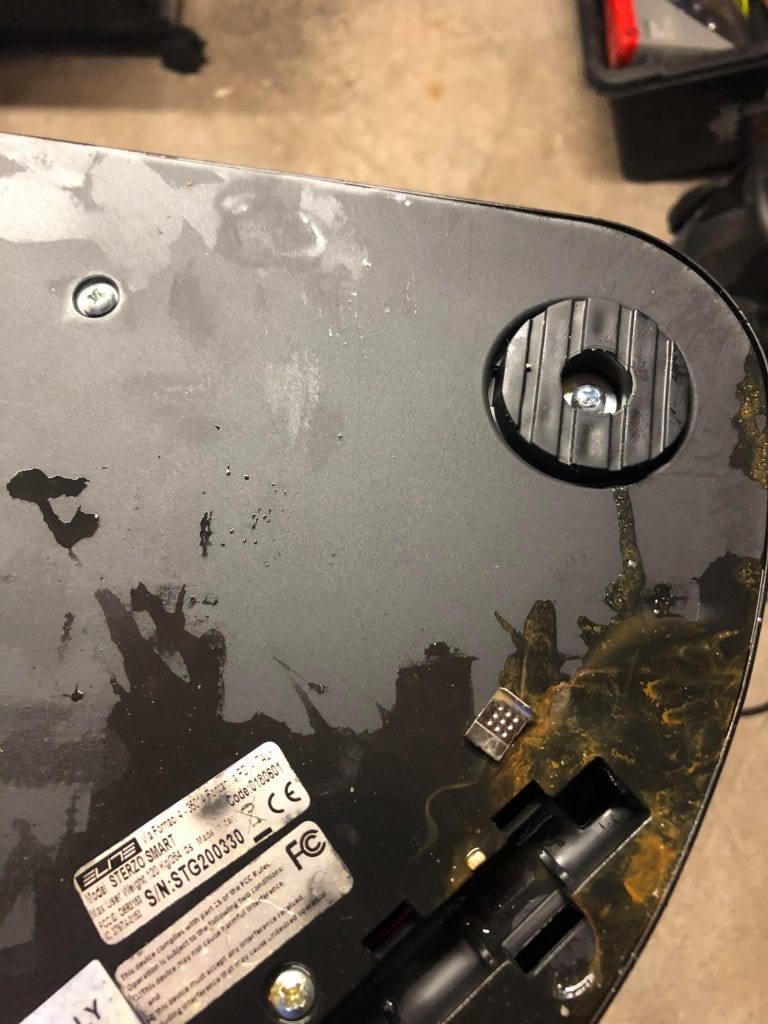
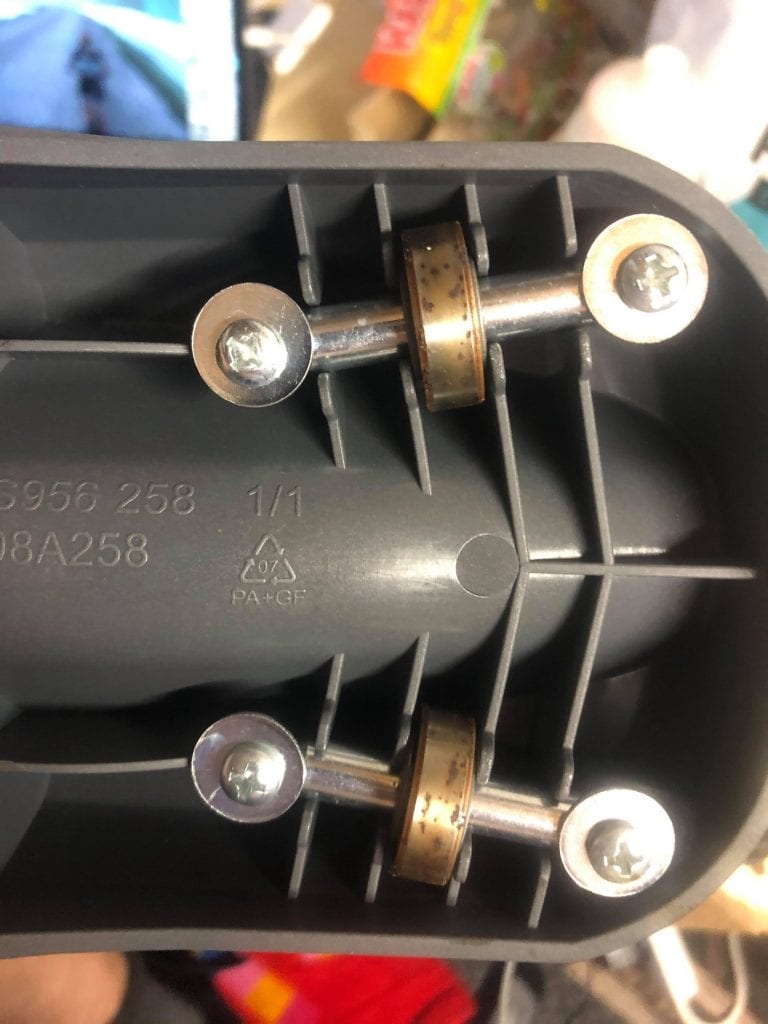
I reached out to Elite about this issue, sharing the photos above which came from fellow Zwifter Mike Lister. Here’s what they had to say:
Needless to say we did testing with multiple persons for multiple training sessions for multiple weeks but the images you sent from FB are very clear. So to cut to the chase, we will clearly substitute next week this person’s Sterzo Smart and will do the same for anyone else encountering the same issue and we already have our Tech team working on solutions to keep the compartment isolated with Sterzo Smart totally submerged underwater.
Kudos to Elite for being willing to quickly replace rusted Sterzos. If you need a replacement, reach out to Elite’s support at support.elite-it.com.
Here are some simple ways you can avoid rust issues on your Sterzo:
- Towels are your friend:
- If you’re on a soft floor, lay a towel beneath your Sterzo so it can soak up sweat without allowing it to puddle and fry your batteries.
- Place a towel between your Sterzo and front tire, large enough that it covers the entire Sterzo and moves smoothly with your steering. This will soak up any sweat drops and keep your Sterzo dry and happy.
- Wipe any moisture off your Sterzo after each session, and run the wheels over a towel to make sure they’re dry.
- Use a towel on your handlebars to catch much of the sweat that would otherwise drip straight down.
- Duct tape fixes everything: apply duct tape over the battery compartment to seal it from sweat.
- Fan support: a strong fan like the Wahoo Headwind should blow sweat drops back far enough that they’ll miss your Sterzo entirely. That’s been my saving grace!
Conclusions
The Sterzo works well as a steering device, although it isn’t perfect. (It’s a first-run product after all, and this is FutureWorks steering – so I don’t expect perfection at this stage.) Yet even in this early phase, steering on Zwift is fun, especially for races. I’m really looking forward to taking part in races where everyone has a Sterzo – that will be interesting!
There are three Sterzo improvements that need to be on Zwift/Elite’s shortlist, in my opinion:
- Make Pairing Faster/Seamless: with such a simple device, pairing should be quick and easy, every time. I think we’ll get there.
- Tilt-Adjustable: make the two front feet height-adjustable so users can dial in the tilt a bit, or offer aftermarket feet to accomplish this. (Note: this has the added benefit of keeping the battery compartment off the wet pain cave floor!)
- Stop the Rust: rusting after just a few days of use is unacceptable. The battery compartment needs to be relocated and/or sealed, and the wheels need to be replaced with something that won’t rust such as plastic or stainless steel. I’m happy to hear that Elite is working on improvements in this area.
Your Thoughts
Share in the comments below!
